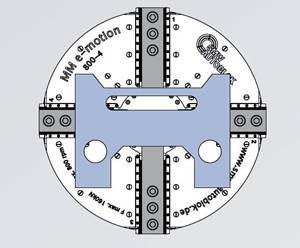Saving Energy Synergistically
Energy-saving systems serve as an example of a machine tool functioning as a cyber physical system in which control loops are self-monitoring and self-adapting.
The push for energy conservation is on, and many machine tool builders have already developed systems to help manufacturers reduce their levels of energy consumption. Most of these developments involve dashboard-type systems that display exactly how much power a machine is using so that manufacturers can then take appropriate actions to reduce it.
The next logical step for systems is to automatically initiate energy saving tactics according to schedule over the course of a week. One example of such a system that is currently available shows how this works. It is the proactive machine tool energy conservation system called Econowatt II, developed by GF Machining Solutions for its AgieCharmilles wire EDMs and Mikron high-performance milling machines.
This system is an extension of the company’s Econowatt I development, which focused on machine peripherals to reduce power consumption by switching off coolant pumps, generators, fans, chillers, machine lights and display screens after the machine finished a job or when it was idle. However, the user had to program its energy saving functions by entering special M codes in part programs. The newer version of this technology provides an additional control page/screen specifically for programming the system, thereby eliminating the need to add programming codes. It also includes functions such as selectable standby modes, wake-up cycles and most notably, scheduling capabilities. Equally significant, users can access and program the Econowatt II system remotely via the company’s E-Monitoring system. Data from Econowatt II can be collected and analyzed on networked applications as well.
On the programming screen, the times and days when machine peripherals will turn off and on can be designated for a seven-day period. A shop could, for example, program the system to switch off machine peripherals every day at 5 p.m. and turn them back on at 6 a.m. the following day, or switch them off on a Friday and have them power back up on Monday. Peripherals can also be programmed to switch off at the end of a part program or if a machine error occurs. For example, programmed wake-up cycles will energize a machine’s peripherals so that production time is not lost waiting for the machine to warm up.
On the system’s control screen, a speedometer-like display called the Econometer shows all of the machine’s energy consumption levels at a particular moment. It also tracks those levels over a specified period of time. For example, a history of energy savings in kilowatts per hour can be reviewed from the time the system was installed.
A study of this system running on a Mikron Mill S400U projected these results: In one year, on a one-shift basis, energy consumption would be reduced by 34,000 kWh (the equivalent of the energy consumed by five average residential houses.) Typically, this reduction would equal a $4,000 annual savings on the shop’s utility bill. With all the of Econowatt functions operating, the carbon footprint of this machine would also be considerably smaller. The system would prevent the equivalent of 23.8 tons of carbon dioxide from being released into the atmosphere.
Accompanying this energy conservation system should be two other essential tactics that make up a machine tool builder’s total energy-saving strategy. One is designing a machine for lower energy consumption. This includes reducing mass in moving components without compromising stiffness and rigidity, using lighter carbon fiber materials in place of steel (in spindle jackets, for example), installing a hydraulic system with an accumulator to avoid running the pump continuously, switching to LED lighting, offering options for minimum quantity lubrication, and other design innovations. The other tactic is promoting more efficient machining operations such as continuous running in lights-out mode, combining milling and turning capability on one machine (multitasking), and CNC programming for high material-removal rates.
Finally, energy-savings systems serve as an example of a machine tool functioning as a cyber physical system in which control loops are self-monitoring and self-adapting. Clearly, this is the wave of the future in production management.
Related Content
Reinventing a Precision Shop With a Data-Driven Mindset
When this machine shop lost 90% of its business within three months, a reinvention was in order. Here's how it survived after quickly falling on hard times.
Read MoreWireless Couplers Work Wonders for Workholding
Possibilities range from individual control of chuck jaws and tombstone fixtures to more reliable robots.
Read MoreShop Quotes Smarter, Works Harder with Machine Monitoring
Temco first installed MT-LINKi to optimize quoting. Now, the software helps the shop optimize its machines — and machine purchases.
Read MoreHow this Job Shop Grew Capacity Without Expanding Footprint
This shop relies on digital solutions to grow their manufacturing business. With this approach, W.A. Pfeiffer has achieved seamless end-to-end connectivity, shorter lead times and increased throughput.
Read MoreRead Next
The Cut Scene: The Finer Details of Large-Format Machining
Small details and features can have an outsized impact on large parts, such as Barbco’s collapsible utility drill head.
Read More3 Mistakes That Cause CNC Programs to Fail
Despite enhancements to manufacturing technology, there are still issues today that can cause programs to fail. These failures can cause lost time, scrapped parts, damaged machines and even injured operators.
Read More










.png;maxWidth=300;quality=90)


.png;maxWidth=300;quality=90)








